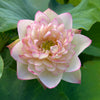Plant Description
New Cloud Brocade Lotus has elegant blooms in shades of cream with a whisper of green over the inner petal tips and a blush of pink on the outer petal tips. The flowers on this spectacular lotus have a lavish drape and are adorned with yellow-gold receptacles. New Cloud Brocade Lotus adds a beautiful aesthetic touch. to your water garden setting. Tall/Versicolor/Multi-Petal
How to plant your lotus tuber
Your lotus tuber may be planted in a wide, no holes container (24 - 48 inches in diameter) or wider. Fill the container 3/4 full with loam soil. Dig a shallow trench across the surface of the soil and gently place your lotus tuber in the trench. Take care not to damage the growth tips on the lotus tuber as this is where the growth of your lotus begins. Cover the tuber with an inch of soil while leaving the growth tips exposed. Gently add 4 - 5 inches of water above the soil. Place your container in a sunny spot where it will receive 8 - 12 hours of sunlight daily. In a week or two you should have coin leaves growing on the surface of the water. A week or two after that you should have aerial leaves growing out of the water. Once you have aerial leaves, you may fertilize your lotus.
How to fertilize your lotus
We recommend a slow release fertilizer like Waterlily World Fertilizer tabs. For the first dose of fertilizer we recommend only 1/2 a dose. Simply press the fertilizer tabs into the soil near the roots of your lotus, taking care not to damage the roots. Two weeks after the first dose you may fertilize your lotus again with a full dose of fertilizer. We recommend fertilizing once a month throughout the growing/blooming season, your last dose of fertilizer should be in September. This allows your lotus to go into dormancy naturally.
Please read our complete Lotus Growing Guide included in your lotus purchase!
What Is Loam Soil?
Loam soil is a good mixture of Topsoil and Sand
If you are lucky enough to have good topsoil in your backyard, by all means, use your topsoil. All you will have to do is add fertilizer. If you are not so lucky--and your backyard is sand or heavy red or yellow clay, you can mix up a batch of loam soil.
You can create your own loam soil by mixing these two ingredients together
- 2/3 Inorganic Topsoil (Little or no organic material added)
- 1/3 Pool Filter Sand
Mix together thoroughly with a little water. Your soil should clump when squeezed. If your soil is mixed properly, it will not muddy your pond water.
You can purchase inexpensive bags of inexpensive / poor Topsoil at Lowes or Home-Depot. Good soil clumps together as a ball in your hand with only a little moisture.
Don't buy brands like Scott's or Miracle-Gro, as they will contain too much organic matter that can foul your water. Buy an unbranded bag of topsoil instead.
You can purchase Pool Filter Sand at any store that sells pool supplies.
Loam soil is well suited for all aquatic plants (except oxygenators). Oxygenators rarely need to be planted, just anchored in the substrate or in a container filled with sand or 1/8 inch pea gravel.
Sand holds little water but does allow for aeration and drainage.
Some DO's and DON'TS regarding Aquatic Planting Soil
DO NOT use potting soils ( as they are too light and will float right out of the pot). Potting Soil has organic material that will rot and foul your water!
DO NOT add too much composted material (as it is too rich in organic matter and it will ferment underwater and destroy the ecology of your pond).
DO NOT use 100% calcined clay as there is no nutritional value in calcined clay.
DO NOT add rocks, stones or pebbles to the top of your planting container as this will inhibit the growth of your plants. Plants do not grow in rocks and stones in nature!
DO NOT purchase API Aquatic Planting Media or Microbe-lift Aquatic Planting Media as these products are NOT suitable for waterlilies, lotus or most other pond plants. They are suitable for submerged grasses ONLY!










